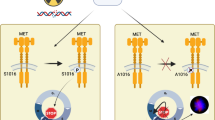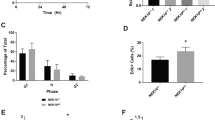Abstract
The tumour suppressor gene product, p53, is involved in mediating cellular responses to DNA damage including growth arrest and/or apoptosis. The mechanism by which p53 protein senses the presence of damaged DNA is not understood. The possibility that p53 may be post-translationally modified by enzymes that are activated in response to DNA damage including DNA-dependent protein kinase (DNA-PK), poly(ADP-ribose) polymerase and stress activated protein kinase has received considerable attention. Recent studies have indicated that DNA-PK is not required for the transactivation or apoptosis-promoting activities of p53 protein. However, the possibility that other functions of p53 may be dependent on phosphorylation by DNA-PK has not been explored. Here we describe a series of experiments that compares the expression, function and phosphorylation status of p53 protein in normal and DNA-PK-deficient scid cells. While several novel p53 phosphoforms are generated in response to DNA damage in normal cells, the same phosphoforms are observed in scid cells.
This is a preview of subscription content, access via your institution
Access options
Subscribe to this journal
Receive 50 print issues and online access
$259.00 per year
only $5.18 per issue
Buy this article
- Purchase on Springer Link
- Instant access to full article PDF
Prices may be subject to local taxes which are calculated during checkout







Similar content being viewed by others
References
Adams LD and Gallagher SR. . 1995 Current Protocols in Molecular Biology. Janssen K. (ed.).. John Wiley and Sons: USA, vol. 2 pp. 10.4.1–13.
Anderson CW. . 1993 Trends Biochem. Sci. 18: 433–437.
Anderson CW. . 1994 Semin. Cell Biol. 5: 427–436.
Bates S and Vousden KH. . 1996 Curr. Opin. Genet. Dev. 6: 12–18.
Bogue MA, Zhu C, Aguilar-Cordova E, Donehower LA and Roth DB. . 1996 Genes & Dev. 10: 553–565.
Bosma MJ and Carroll AM. . 1991 Ann. Rev. Immun. 9: 323–350.
Chernov MV, Ramana CV, Adler VV and Stark GR. . 1998 Proc. Natl Acad. Sci. USA 95: 2284–2289.
Chernov MV and Stark GR. . 1997 Oncogene 14: 2503–2510.
Donehower LA, Harvey M, Slagle BL, McArthur MJ, Montgomery Jr CA, Butel JS and Bradley A. . 1992 Nature 356: 215–221.
Dover R, Jayaram Y, Patel K and Chinery R. . 1994 J. Cell Sci. 107: 1181–1184.
Fiscella M, Ullrich SJ, Zambrano N, Shields MT, Lin D, Lees-Miller SP, Anderson CW, Mercer WE and Appella E. . 1993 Oncogene 8: 1519–1528.
Fiscella M, Zambrano N, Ullrich SJ, Unger T, Lin D, Cho B, Mercer WE, Anderson CW and Appella E. . 1994 Oncogene 9: 3249–3257.
Fried LM, Koumenis C, Peterson SR, Green SL, van Zijl P, Allalunis-Turner J, Chen DJ, Fishel R, Giaccia AJ, Brown JM and Kirchgessner CU. . 1996 Proc. Natl Acad. Sci. USA 93: 13825–13830.
Fu L and Benchimol S. . 1997 EMBO J. 16: 4117–4125.
Fuchs B, O'Connor D, Fallis L, Scheidtmann KH and Lu X. . 1995 Oncogene 10: 789–793.
Fulop GM and Phillips RA. . 1990 Nature 347: 479–482.
Guidos CJ, Williams CJ, Grandal I, Knowles G, Huang MT and Danska JS. . 1996 Genes Dev. 10: 2038–2054.
Hall SR, Campbell LE and Meek DW. . 1996 Nucl. Acids Res. 24: 1119–1126.
Hao M, Lowy AM, Kapoor M, Deffie A, Liu G and Lozano G. . 1996 J. Biol. Chem. 271: 29380–29385.
Hartley KO, Gell D, Smith GC, Zhang H, Divecha N, Connelly MA, Admon A, Lees-Miller SP, Anderson CW and Jackson SP. . 1995 Cell 82: 849–856.
Huang LC, Clarkin KC and Wahl GM. . 1996 Cancer Res. 56: 2940–2944.
Hupp TR, Meek DW, Midgley CA and Lane DP. . 1992 Cell 71: 875–886.
Jacks T, Remington L, Williams BO, Schmitt EM, Halachmi S, Bronson RT and Weinberg RA. . 1994 Curr. Biol. 4: 1–7.
Jayaraman L and Prives C. . 1995 Cell 81: 1021–1029.
Jiang D, Lenardo MJ and Zuniga-Pflucker C. . 1996 J. Exper. Med. 183: 1923–1928.
Khanna KK and Lavin MF. . 1993 Oncogene 8: 3307–3312.
Lees-Miller SP, Sakaguchi K, Ullrich SJ, Appella E and Anderson CW. . 1992 Mol. Cell. Biol. 12: 5041–5049.
Levine AJ. . 1997 Cell 88: 323–331.
Maltzman W and Czyzyk L. . 1984 Mol. Cell. Biol. 4: 1689–1694.
Mayo LD, Turchi JJ and Berberich SJ. . 1997 Cancer Res. 57: 5013–5016.
Mayr GA, Reed M, Wang P, Wang Y, Schweds JF and Tegtmeyer P. . 1995 Cancer Res. 55: 2410–2417.
Meek DW. . 1994 Sem. Cancer Biol. 5: 203–210.
Milne DM, Palmer RH and Meek DW. . 1992 Nucl. Acids Res. 20: 5565–5570.
Mosner J, Mummenbrauer T, Bauer C, Sczakiel G, Grosse F and Deppert W. . 1995 EMBO J. 14: 4442–4449.
Murphy KM, Heimberger AB and Loh DY. . 1990 Science 250: 1720–1723.
Nacht M, Strasser A, Chan YR, Harris AW, Schlissel M, Bronson RT and Jacks T. . 1996 Genes Dev. 10: 2055–2066.
Price BD and Youmell MB. . 1996 Cancer Res. 56: 246–250.
Rathmell WK, Kaufmann WK, Hurt JC, Byrd LL and Chu G. . 1997 Cancer Res. 57: 68–74.
Rotter V, Schwartz D, Almon E, Goldfinger N, Kapon A, Meshorer A, Donehower LA and Levine AJ. . 1993 Proc. Natl Acad. Sci. USA 90: 9075–9079.
Sakaguchi K, Sakamoto H, Lewis MS, Anderson CW, Erickson JW, Appella E and Xie D. . 1997 Biochemistry 36: 10117–10124.
Shieh SY, Ikeda M, Taya Y and Prives C. . 1997 Cell 91: 325–334.
Shimonkevitz R, Colon S, Kappler JW, Marrack P and Grey HM. . 1984 J. Immunol. 133: 2067–2074.
Siliciano JD, Canman CE, Taya Y, Sakaguchi K, Appella E and Kastan MB. . 1997 Genes Dev. 11: 3471–3481.
Spaner D. . 1994 Res. Immunol. 145: 337–344.
Steegenga WT, van der Eb AJ and Jochemsen AG. . 1996 J. Mol. Biol. 263: 103–113.
Towbin H, Staehelin T and Gordon J. . 1979 Proc. Natl Acad. Sci. USA 76: 4350–4354.
Wu JM, Chen Y, An S, Perruccio L, Abdel-Ghany M and Carter TH. . 1993 Biochem. Biophys. Res. Commun. 193: 13–18.
Yeargin J and Haas M. . 1995 Curr. Biol. 5: 423–431.
Acknowledgements
We thank Dr Jim Woodgett for anti-GSK-3β antibodies and Dr Paul Fraser for anti-tau antibody. We are grateful to Drs Jim Woodgett, Norman Iscove and Gillian Wu for their advice and comments. This work was supported by the Medical Research Council of Canada and the National Cancer Institute of Canada.
Author information
Authors and Affiliations
Rights and permissions
About this article
Cite this article
Abraham, J., Spaner, D. & Benchimol, S. Phosphorylation of p53 protein in response to ionizing radiation occurs at multiple sites in both normal and DNA-PK deficient cells. Oncogene 18, 1521–1527 (1999). https://doi.org/10.1038/sj.onc.1202454
Received:
Revised:
Accepted:
Published:
Issue Date:
DOI: https://doi.org/10.1038/sj.onc.1202454



